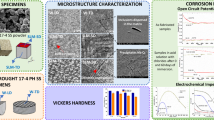Scanning electron microscopy and confocal laser scanning microscopy are used to study a fracture surface of hydrogen-charged low-carbon steel, which has been deformed in air at room temperature to 12% residual strain and then crushed in liquid nitrogen. It is shown that the quasi-cleavage facets formed during the room-temperature deformation have a strongly curved surface in contrast to the flat cleavage facets formed under the loading in liquid nitrogen. It is inferred that the quasi-cleavage facets in the hydrogen-charged steel do not form by the mechanism of cleavage in the deformed structure.



Similar content being viewed by others
References
S. P. Lynch, “Hydrogen embrittlement phenomena and mechanisms,” Corros. Rev., 30, 63 – 133 (2012) (doi: https://doi.org/10.1515/corrrev-2012-0502).
I. M. Robertson, P. Sofronis, A. Nagao, et al., “Hydrogen embrittlement understood,” Metall. Mater. Trans. A, 46, 2323 – 2341 (2015) (doi: https://doi.org/10.1007/s11661-015-2836-1).
M. Koyama, H. Springer, S. V. Merzlikin, et al., “Hydrogen embrittlement associated with strain localization in a precipitation-hardened Fe – Mn – Al – C light weight austenitic steel,” Int. J. Hydrogen Energy, 39, 4634 – 4646 (2014) (doi: https://doi.org/10.1016/j.ijhydene.2013.12.171).
S. Wang, M. L. Martin, P. Sofronis, et al., “Hydrogen-induced intergranular failure of iron,” Acta Mater., 69, 275 – 282 (2014) (doi: https://doi.org/10.1016/j.actamat.2014.01.060).
L. P. Botvina, T. V. Tetyueva, and A. V. Ioffe, “Stage nature of multiple fracture of low-alloy steels in hydrogen environment,” Metalloved. Term. Obrab. Met., No. 2, 14 – 22 (1998).
T. Neeraj, R. Srinivasan, and J. Li, “Hydrogen embrittlement of ferritic steels: Observations on deformation microstructure, nanoscale dimples and failure by nanovoiding,” Acta Mater., 60, 5660 – 5171 (2012) (https://doi.org/10.1016/j.actamat.2012.06.014).
M. L. Martin, J. A. Fenske, G. S. Liu, et al., “On the formation and nature of quasi-cleavage fracture surfaces in hydrogen embrittled steels,” Acta Mater., 59, 1601 – 1606 (2011) (doi: https://doi.org/10.1016/j.actamat.2010.11.024).
D. Ya. Povolotskii and A. N. Morozov, Hydrogen and Flakes in Steel [in Russian], Metallurgizdat, Moscow (1959), 182 p.
E. Merson, A. Vinogradov, and D. L. Merson, “Application of acoustic emission method for investigation of hydrogen embrittlement mechanism in the low-carbon steel,” J. Alloys Compd., 645, 460 – 463 (2015) (doi: https://doi.org/10.1016/j.jallcom.2014.12.083).
M. R. Louthan, “Hydrogen embrittlement of metals: a primer for the failure analyst,” J. Fail. Anal. Prev., 8, 289 – 307 (2008) (doi: https://doi.org/10.1007/s11668-008-9133-x).
A. Nagao, C. D. Smith, M. Dadfarina et al., “Interpretation of hydrogen-induced fracture surface morphologies for lath martensitic steel,” Proc. Mater. Sci., 3, 1700 – 1705 (2014) (doi: https://doi.org/10.1016/j.mspro.2014.06.274).
M. L. Martin, I. M. Robertson, and P. Sofronis, “Interpreting hydrogen-induced fracture surfaces in terms of deformation processes: A new approach,” Scr. Mater., 59, 3680 – 3687 (2011) (doi: https://doi.org/10.1016/j.actamat.2011.03.002).
S. P. Lynch, “Interpreting hydrogen-induced fracture surfaces in terms of deformation processes: A new approach,” Scr. Mater., 65, 851 – 854 (2011) (doi: https://doi.org/10.1016/j.scriptamat.2011.06.016).
A. Kumar, A. J. Wilkinson, and S. G. Roberts, “Quasi-cleavage fracture planes in spheroidized A533B steel,” J. Microsc., 227, 248 – 253 (2007) (doi: https://doi.org/10.1111/j.1365-2818.2007.01808.x).
M. A. Shtremel, Fracture, Book 2 [in Russian], Izd. Dom. MISiS, Moscow (2015), 975 p.
E. Merson, A. V. Kudrya, V. A. Trachenko, et al., “Quantitative characterization of cleavage and hydrogen-assisted quasi-cleavage fracture surfaces with the use of confocal laser scanning microscopy,” Mater. Sci. Eng. A, 665, 35 – 46 (2016) (doi: https://doi.org/10.1016/j.msea.2016.04.023).
E. D. Merson and V. A. Poluyanov, “Stage nature of growth of “fish eye”-type cracks under uniaxial tension of low-carbon steel saturated with hydrogen,” in: Proc. XVI Int. Sci.-Eng. Ural Workshop of Young Metal Scientists [in Russian], Ekaterinburg (2015), pp. 343 – 346.
M. Naguma, Fundamentals of Hydrogen Embrittlement, Springer Singapore, Singapore (2016) (doi: https://doi.org/10.1007/978-981-10-0161-1).
S. P. Lynch, “Environmentally assisted cracking: Overview of evidence for an adsorption-induced localised-slip process,” Acta Metall., 36, 2639 – 2661 (1988) (https://doi.org/10.1016/0001-6160(88)90113-7).
The work has been performed with financial support of the Russian Foundation for Basic Research (Grant 17-08-01033).
Author information
Authors and Affiliations
Corresponding author
Additional information
Translated from Metallovedenie i Termicheskaya Obrabotka Metallov, No. 3, pp. 53 – 57, March, 2019.
Rights and permissions
About this article
Cite this article
Merson, E.D., Poluyanov, V.A., Merson, D.L. et al. About the Nature of Quasi-Cleavage in Low-Carbon Steel Embrittled with Hydrogen. Met Sci Heat Treat 61, 191–195 (2019). https://doi.org/10.1007/s11041-019-00399-x
Published:
Issue Date:
DOI: https://doi.org/10.1007/s11041-019-00399-x




